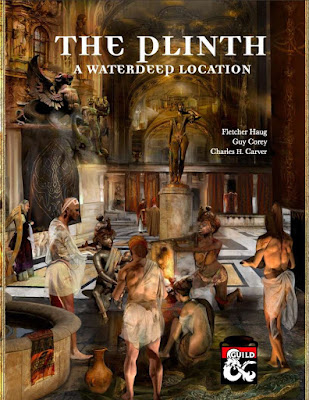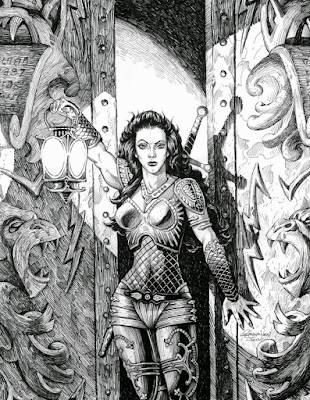1974 is an important year for the gaming hobby. It is the year that
Dungeons & Dragons was introduced, the original RPG from which all other RPGs would ultimately be derived and the original RPG from which so many computer games would draw for their inspiration. It is fitting that the current owner of the game, Wizards of the Coast, released the new version,
Dungeons & Dragons, Fifth Edition, in the year of the game’s fortieth anniversary. To celebrate this, Reviews from R’lyeh will be running a series of reviews from the hobby’s anniversary years, thus there will be reviews from 1974, from 1984, from 1994, and from 2004—the thirtieth, twentieth, and tenth anniversaries of the titles. These will be retrospectives, in each case an opportunity to re-appraise interesting titles and true classics decades on from the year of their original release.
—oOo—

As the hobby in 2020 awaits the much-anticipated release of
Cyberpunk Red, the fourth edition of
Cyberpunk, the year also marks the thirtieth anniversary of both its highly regarded forebear,
Cyberpunk 2.0.2.0., and another roleplaying game designed by Mike Pondsmith. That roleplaying game is
Buck Rogers XXVC, or ‘Buck Rogers in the 25th Century’. Published by TSR, Inc. in 1990, as the title suggests
Buck Rogers XXVC is based upon the character originally created by Philip Francis Nowlan in the novella
Armageddon 2419 A.D., and subsequently popularised in newspaper comic strips, a film serial in the late nineteen thirties, and then a television series in the late nineteen seventies and early nineteen eighties. In the original novella, Buck Rogers is frozen in a mine by radioactive gas and kept in a state of suspended animation for nearly five centuries, only to awake in 2419 to find a North America ruled by the Air Lords known as the Han and their allied gangs from fifteen great cities, Americans left to fend themselves beyond the confines of the cities, but putting up a resistance against the Han and their gang allies. The original novella, the film serial, the television series, and both roleplaying games—TSR, Inc. publishing
Buck Rogers XXVC in 1990 and then the
High Adventure Cliffhangers Buck Rogers Adventure Game in 1993—have expanded upon, to varying degrees, the scope of their Buck Rogers settings. For example, the
Buck Rogers in the 25th Century television series takes the character and story into space and beyond the confines of the solar system, and its look is influenced by
Star Wars, at the time being nearly everyone’s idea of what Science Fiction should be like;
Buck Rogers XXVC takes the character into the space, but only the confines of the solar system, and its Science Fiction, is more Pulpy in its styling; and the
High Adventure Cliffhangers Buck Rogers Adventure Game takes Buck Rogers back to his roots of the novella—a conflict set on Earth only, fought with the technology of the Great War and the nineteen twenties. What they share in common is the same cast of characters, and of course, Buck Rogers himself, a man out of the past, frozen in time for centuries, and awoken to help to fight an oppressive enemy.
Buck Rogers XXVC would be TSR, Inc.’s second attempt at a Science Fiction roleplaying game, following on from 1982’s well-regarded
Star Frontiers, and preceding the
High Adventure Cliffhangers Buck Rogers Adventure Game and the
Amazing Engine and its subsequent line of supplements—both from 1993, and finally
Alternity in 1998. It would come about because Lorraine Williams, the then president of TSR, Inc., was the granddaughter of John F. Dille, the publisher who had originally syndicated Philip Francis Nowlan’s
Buck Rogers comic strip and as a property,
Buck Rogers, is owned by the Dille Family Trust. Williams wanted to combine Buck Rogers with the popularity of
Advanced Dungeons & Dragons, and this would lead to the development of a new background for
Buck Rogers, by Williams’ brother, Flint Dille. This new background would be initially showcased in 1988 in the board game,
Buck Rogers - Battle for the 25th Century, and then the roleplaying game,
Buck Rogers XXVC, in 1990.
The setting for
Buck Rogers XXVC is the year 2456. The twenty-fifth century is a future in which atomic powered rocket ships fly between the plants of the solar system, great power blocs work to terraform Mars and Venus, corporate warlords use genetically engineered workers and warriors to dominate whole worlds and enforce their will, and an Earth, a political and economic backwater still recovering from a war in the first half of the twenty-first century, bucking against off-world powers who see it as a source of clean water, historical art and objects and treasures, and other resources to be plundered. The solar system is dominated by three great power blocs, formed in response to the Last Gasp War fought between the United States of America and the Soviet Communist bloc which began with the successful destruction of Russia’s powerful new orbital offence system, Masterlink, by United States Air Force Lieutenant Colonel Anthony ‘Buck’ Rogers—who was assumed killed in the attempt and ended in a limited exchange of nuclear missiles. The three power blocs, the Russo-American Combine (RAM), the Euro-Bloc faction, and the Indo-Asian Consortium (IAC) quickly formed a world government and then, as the rest of the solar system was explored, settled, and terraformed, the System States Alliance. Each bloc claimed a different world, RAM took Mars, the Euro-Bloc Luna, and the IAC Venus, with both RAM and the IAC making great efforts to terraform their worlds. To date, both RAM and the IAC have made great strides such that parts of both worlds are habitable. Ultimately, RAM would rebel against the System States Alliance and by the end of the Ten Year War in 2285, break both Earth as a power and fearing the IAC as an economic rival, sabotage colonisation and terraforming efforts on Venus. As RAM tightened its grip and influence on the Solar System, refugees from Earth, Mars, and Venus would flee to Mercury where the most powerful colonists would establish a ‘Sun King’ monarchy made wealthy on the energy and minded ores it sold to the rest of the solar System. A later wave of refugees would flee into the asteroids, and to Jupiter and Saturn, these Outer Worlds eventually to become home to The Black Brotherhood, bands of pirates feared for their raids across the system. Earth, the majority of its population residing in Arcologies, with mutants confined to reservations or the polluted and scavenged Badlands, and its technology regressed to that of the twentieth century, is under the thumb of RAM, as part of its ‘Solar Alliance Protectorate’. More recently, an alliance of smugglers, traders, and rebels who have banded together to form the New Earth Organisation (NEO), an underground resistance group dedicated to freeing Earth from RAM’s yoke. (Notably, parallels are drawn between NEO and RAM, and the Continental Army and British forces during the American War of Independence, but of course, NEO’s enemy is corporate, rather than imperial, though no less autocratic.) Recently, NEO’s hopes and plans have been bolstered by the discovery and revival of Buck Rogers, the hero of The Last Gasp War.
Buck Rogers XXVC comes as a richly appointed box set, which start with three black and white books—‘Characters & Combat’, the ninety-six-page rulebook; the sixty-four-page ‘The World Book’, which covers the background and includes information and a scenario for the Referee’s eyes only; and the thirty-two-page ‘The Technology Book’, which covers the setting’s equipment and weaponry. The Referee is given a plain, but serviceable Reference Screen: Tables and Statistics, plus twenty-four reference cards. On the font of these is a full colour illustration, showing either a ship, an NPC—such as Ardala Valmar, Buck Rogers, or Killer Kane, or a map of one of the setting’s worlds, with the stats and background on the back. These reference cards feel reminiscent of Spelljammer, the space setting for Advanced Dungeons & Dragons, Second Edition. There are two double-sided poster maps. One poster has a map of Tycho Arcology Spaceport on one side and an outer-space hex grid for running space combat on the other, whilst the other poster has the deck plans for a small cruiser and a medium cruiser—both suitable for use with 25 mm figures—on one side, and a map of the orbits of the inner planets and various settlements in the Asteroid Belt on the other. Lastly, there is sheet of counters for use on the maps, a set of polyhedral dice, and a plastic overlay. This is used to determine travel and communication times between the planets as they orbit around the sun, the Referee having to move them along in their orbital paths once every thirty days in game to reflect the changing distances. Overall, the box set is nicely appointed.
Buck Rogers XXVC is a classic Race, Class—or Career, and Level system. It is based on
Advanced Dungeons & Dragons, Second Edition, but with various tweaks to account for the genre. The Player Characters, traders, adventurers, spies, resistance fighters, and more, are assumed to be members of, or at least affiliated to NEO. A Player Character is defined by seven attributes—Strength, Dexterity, Intelligence, Constitution, Wisdom, Charisma, and Tech. These provide various bonuses, notably serving as a bonus to skill rolls, and range in value from one to twenty-two. A Character also has a Race,
Buck Rogers XXVC offering thirteen options. They start with Terrans, unmodified Humans, and then add Martians, Lunarians, Venusians, and Mercurians, each type having been modified to survive on their respective home worlds. The other eight are ‘gennies’, or ‘genetic mutants’, modified with animal DNA to survive in certain conditions or perform various tasks. So Tinkers are crossed with lemurs and gibbons, and are short, have long fingers, a longer reach, and fine fur and are suited to engineering and technical tasks—especially in tunnels; the Martian Desert Runner has feline and canine DNA to give claws and the ability to run on all fours, and webbing between fingers and toes to run on the sands of Mars; and the dread Terrine have Shark DNA with tough skeletons, retractable talons on hands and feet, and sandpaper-like skin, and are bred by RAM as its shock troops. In terms of Class—or Career,
Buck Rogers XXVC gives Rocketjocks, the pilots of the setting, Warriors—fighters and professional soldiers, Scouts—planetary explorers and loners, Engineers, Rogues—gamblers and information traders, and Medics. All six Careers have attribute requirements, and some cannot be selected by Gennies. Each Career provides a few abilities. The Rocketjock grants a bonus to Driving and Piloting skill checks and a Charisma bonus when interacting with a member of the opposite gender; the Warrior rolls a six-sided die for unarmed damage and gains a specialisation bonus every other Level to use a particular weapon, up to +3 for each weapon; a Scout a bonus to his Career skills at each Level; an Engineer receives a to hit and damage bonus when using a tool as a club in combat; the Rogue receives a bonus to his Career skills; and only the Medic can use a Drug Fabricator or Autosurgery. Each Career has its own set of skills. For example, the Rocketjock has Drive Jetcar, Drive Groundcar, Manoeuvre in Zero G, Notice, Pilot Fixed Wing, Pilot Rocket, Pilot Rotorwing Craft, and Use Rocket Belt, whilst the Rogue has Bypass Security, Climb, Fast Talk/Convince, Hide in Shadows, Move Silently, Notice, Open Lock and Pick Pockets.
To create a character, a player rolls three six-sided dice for each attribute, and selects a Race and Career. He divides forty points between his Career skills and another twenty between General skills. He also adds the value of the appropriate attribute to each skill the character has as well as any bonuses from the Career. Each time his character goes up a Level, he will receive another forty points to assign to his Career skills and another twenty to his General skills—that is, those skills not granted by his Career. He then receives between two hundred and two thousand credits to spend on equipment.
Name: Seldona Clarke
Race: Human
Career: Scout Level: 1
Strength 10 (Weight 40, Max. Lift 115, Strength Feat 2)
Dexterity 12
Constitution 09 (System Shock 65)
Intelligence 13
Wisdom 11
Charisma 13
Tech 10
Armour Class: 10
Hit Points: 8
Abilities
N/A
Career Skills
Animal Riding (Dex) 13, Befriend Animal (Chr) 01, Climb (Dex) 18, Move Silently (Dex) 17, Notice (Wis) 16, Planetary Survival (Wis) 16, Planetology (Int) 27, Tracking (Wis) 16
General Skills
Cook (Tech) 15, Geology (Int) 18, Navigation (Int) 18, Sensor Operation (Tech) 15
Equipment
Laser Pistol, Mono Knife, Utility Belt, Smart Clothes, Messkit, Backpack, Inertial Compass, Cr 75
Mechanically,
Buck Rogers XXVC employs not one, but three different mechanics. The first a simple attribute test, a roll equal to, or less than an attribute on a twenty-sided die. The second is the skill check, a roll under—but not equal to, a skill rating. The difficulty of a skill check is directly modified, its skill rating doubled if the task is easy, halved if difficult, and quartered if impossible. The third is the combat roll, rolled on a twenty-sided die, rolled to beat an opponent’s Armour Class. However,
Buck Rogers XXVC being designed in 1990 and not 1992 when
Gamma World, Fourth Edition was published means that
Buck Rogers XXVC uses descending, not ascending Armour Class. Further,
Buck Rogers XXVC being based on
Advanced Dungeons & Dragons, Second Edition, the value used to determine the number a player rolls to his is ‘To Hit Armour Class Zero’, or THAC0.
Armour Class itself runs from nothing and ten down to zero and Battle Armour. Battle Armour with Fields is even lower, and Armour Class is adjusted by cover, Dexterity, and illumination. It is also lowered if a Player Character does nothing but parry or dodge. Combat also covers melee and firearms combat, weapons like the Laser Pistol and Rocket Pistol doing one eight-sided die and one ten-sided die’s worth of damage respectively. At lower Levels, this can be enough to kill a Player Character, and a Player Character whose Hit Points is lowered to zero is dead, unless someone can get the would be corpse to a life suspension device, but these are expensive and bulky. So the likelihood of low Level Player Characters owning one is equally as low… Add in rules for heavy weapons, suffocation, radiation, extreme heat and cold, and until a Player Character has gained a few Levels, the world of
Buck Rogers XXVC is grim and gritty rather than pulpy. That said, the Referee is advised that when possible to narrate ways of his Player Characters surviving near certain death—though not inescapable death!
Buck Rogers XXVC includes rules for both rocketship combat and construction for fighters, cruisers, battlers, transports, and freighters. Ships are expensive, running to hundreds of thousands of Credits. Space combat involves weapons like lasers, missiles, gyrocannons, and acceleration guns, played out at scale of fifty miles per hex. Essentially, a ship’s pilot—ideally a Rocketjock—maneuvers the ship whilst everyone else takes different stations aboard the ship. Weapons need to be manned in order to be fired, the Engineer needs to be able to conduct repairs, the Medic provide first aid, and so on. Each section of ship, whether that is sensors and communications, controls, life support, or hull, has its own individual Hit Points. Reducing any section to zero or fewer Hit Points has the same effect as a critical hit. Otherwise, the ship combat rules work as per personal combat, including the use of THCA0, and are serviceable enough.
Apart from the addition of Gennies, the other significant technology in
Buck Rogers XXVC is that of Digital Personalities. Each is an artificial intelligence which can project a three-dimensional image of itself, which mechanically has mental, but not physical attributes. A Digital Personality cannot fight actual people, but can fight other Digital Personalities. A Digital Personality also has the ability to use computer programs such as Control Remote, Stealth, or Virus Attack. A Digital Personality is actually an NPC Career, as is the Scientist, someone who possesses skills and abilities, like gadgeteer, which Player Characters cannot. Notably, Doctor Huer is a Digital Personality, as is the head of RAM, Simund Holzerhein. This is not the only major change to the characters of the Buck Rogers in the 25th Century setting. For example, Ardala Valdemar is a freelance Martian RAM agent with high connections who serves as an information broker and espionage agent, whilst the infamous Rocketjock, Killer Kane, who defected to serve RAM, but only to save his then lover, Wilma Deering. In the meantime, Killer Kane has come to believe that RAM has the people of Earth’s best interests at heart.
In addition to covering each of the worlds of
Buck Rogers XXVC in some detail—their economy and culture, their politics and government, ‘The World Book’ also includes rules for creating more Gennies, guidance for the Referee for running the game and its genre, and a scenario, ‘Ghost in the Machine’. This has a recently fired rocketship crew hired to get hold of a RAM yacht and its secrets before RAM can recover it. Intended for Player Characters of First and Second Level, it should provide sessions of play and enable the Player Characters to try out the various rules, including combat and space combat. ‘The Technology Book’ covers everything from terraforming and space elevators down to personal weapons and gear. Lastly, the Reference Cards present further information on aspects of the setting—major NPCs, the worlds, and ships. They are handy and accessible, providing illustrations and easily accessible content that the Referee can show to her players.
Physically,
Buck Rogers XXVC is generally well presented. The artwork whether black and white in the books, or colour on the Reference Cards is good throughout. Equally, the maps are bright and colourful, though the counters are plain. In general,
Buck Rogers XXVC is well written. Nice touches include the short, but involving ‘choose-your-own-path’ adventure which serves as an introduction to roleplaying in the ‘Characters & Combat’ book, the roleplaying and cultural notes on the various Races, and the Reference Cards, the maps, and the plastic overlay are all great.
Yet mechanically,
Buck Rogers XXVC is underwhelming. In terms of the attributes, only Strength, Dexterity, and Constitution provide any bonuses; there are no special abilities assigned to each Race—at least not in terms of the mechanics; the various abilities Careers feel underpowered and unbalanced, some Careers, like the Rocketjock and the Warrior gaining an improvement every other Level, whilst others like the Engineer and the Medic, a single ability. And, in terms of the Medic, if a playing group wants to have a character who can operate a Drug Fabricator or Autosurgery, then one player has to select that Career, or an NPC be added. Also, there is no mechanical means for the Player Characters to be heroic, so no luck or hero points. It all comes down to the dice rolls, and whilst there is a means to determine the difficulty by adjusting the skill score, there is no corresponding way to handle degrees of success or failure.
Lastly, having three different sets of mechanics—one for attribute checks, one for combat, and one for skills, complicates rather than eases the play of the game. The use of THAC0—the use of THAC0!?—and skills as percentages feels more like a cultural and design clash rather than a decision, almost as if
Buck Rogers XXVC is straining to get away from the constraints of
Advanced Dungeons & Dragons, Second Edition, and be its own thing—rather than a hybrid. Of course,
Buck Rogers XXVC was designed to ride on the back of the popularity of
Advanced Dungeons & Dragons, Second Edition and so was designed to be familiar to the players of that game, but without those constraints, there is no denying that
Buck Rogers XXVC could have been a better game. Indeed, the Referee could easily take the background of
Buck Rogers XXVC and adapt it to the rules of her choice, especially if she wants more competent Player Characters and to reflect a pulpier, more action orientated style that reflects the Space Opera of the nineteen thirties and nineteen forties—the source material for
Buck Rogers XXVC.
There is a great deal to like about
Buck Rogers XXVC—the setting is well done and it is well presented, but ultimately, the mechanics and the low Level of the Player Characters do not feel suited to either the genre or the game.
Buck Rogers XXVC is a great setting to delve into, but not necessarily play as written.





















































